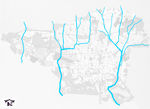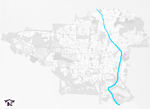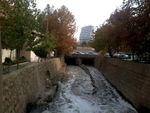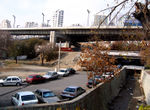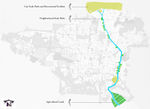Green Infrastructure 2014 Group L - Case Study 2
---> back to group page working group L
Restoration of Darband River Valley with the Approach to a Green, High Quality Transportation Network
| Name | Darband River Valley | |
| Country | Iran | |
| City | Tehran | |
| Authors | Shahla Shahmoradi | |

| ||
|
| ||
Rationale: Why is this case interesting?
River valleys are a valuable feature of Tehran in this arid climate. They act as lungs of a city which bring fresh air from mountains. Unfortunately, there is not much attention to this natural feature in Tehran. Actually, in many parts of the city, their beds have been covered by non-permeable materials, and even worse they have been replaced by highways with a lot of natural and social consequences. On the other hand, Tehran is also a megacity with huge inner-city travels and a burgeoning interest in walking and biking. However, there are not safe and enjoyable spaces to comfortably walk and bike. I see these river valleys a great opportunity to convert to an ecological pathway. Besides discharging stormwater, they have a remarkable potential to more integrate communities, more tie people to nature, make people healthy, and provide a sustainable delightful transportation network.
Author's perspective
I have a bachelor's degree in Urbanism, and worked for about three years in two consulting engineers firms. I currently collaborate with a research office, and research into ecocities. On one of the projects at my previous workplace, I, as a team member, worked on adjacent neighborhoods of a highway. This highway passed through tight neighborhoods with strong relationships. After detailed studies, we found out this highway caused extraordinary disintegration within the communities so that even some children had to cross over the highway to reach their schools. After living near one of these highways which once was a river valley, I have more deeply perceived this disintegration as well as huge noise and air pollution. This has always been my challenge that following this fact that we have a lot of north-south river valleys which have a great potential to convert to a green infrastructure and we need more ways, why we don’t restore these valleys and improve green transportation with the help of them. More dedicating spaces to automobiles means more pollution, more congestion, more illnesses, and more disintegrated communities, while providing delightful environments to walking, biking, and convenient public transportation means more healthy citizens, more environmentally friendly infrastructures, and more sustainable environments and communities, which is what river valleys can give us. Sometimes, I really desire to bike or walk to my destination but in this polluted and automobile-oriented city, I hardly even persuade myself to go out! I believe this megacity with burgeoning population and inner-city travels needs a redefinition of their transportation network toward a sustainable future. My intention of studying this case is restoration of river valleys with the approach to green, high quality transportation network.
Landscape and/or urban context of your case
- Main River Valleys in the City
Seven main river valleys pass through the city, including Darakeh, Velenjak, Darband, Golab Dareh, Jamshidyeh, Darabad, and Kan. All of these come from Alborz Mountains of Tehran, and after passing through urban areas reach lower plains in the south, where they meet agricultural lands. My case study concentrates on Darband river valley, which passes alongside my neighborhood.
- Overall Character and Current Conditions
By carefully looking at the map, Darband river valley and its path is recognized due to its especial natural form. But if we want to follow it in the city, it is not so easy. Some parts of it have been buried under buildings or streets. Other parts of it have been converted to "U" channels and covered by impervious materials such as stone. In terms of flora, except some scattered trees, which are planted alongside the wall of the river valley, there is not major planting adjacent to that. Actually the deep channels surrounding the bed of the river valley has taken the opportunity to plant trees, shrubs, or other kinds of vegetation. Right after the end of the river's walls, there are streets and buildings. This lack of attention to Darband river valley causes people to undermine it and throw their wastes in this river-channel, and this in turn causes major environmental pollution in the site.
- Flora
Tehran is rich in terms of the diversity of flora. While some of them are native to Iran, few, if any, of them are endemic to Tehran. Up to now, 13 endemic species of Tehran are known: Eritrichium mertonii (Family Boraginaceae), Buffonia hebecalyx (Family Caryophyllaceae), Stellaria scaturiginella (Family Caryophyllaceae), Centaurea carduiformis subsp. iranica (Family Compositae), Tanacetum polycephalum subsp. junesarens (Family Compositae), Taraxacum darbandense (Family Compositae), Convolvulus gracilininus (Family Ipomoea), Astragalus latianicus (Family Papaveraceae), Astragalus pseudobrunsianus (Family Papaveraceae), Hedysarum elbursense (Family Papaveraceae), Hedysarum hyrcanum var. hyrcanum (Family Papaveraceae), Vicia sojakii (Family Papaveraceae), Galium tehranicum (Family Rubiaceae). All of these species are herbaceous, which aren’t currently used in parks and landscapes. Predominant species of Tehran which are widely planted in parks, streets, and open spaces as well as alongside the river valleys are Platanus orientals, Morus nigra, Ulmus minor ‘umbraculifera’, Fraxinus excelsior, Quercus spp of broadleaved trees; Pinus eldarica and Cupressus arizonica of conifers; Lignustrum vulgare, Viburnum opulus, Nerium oleander, Berberis thunbergii of shrubs; and Common grass and Hedera helix of cover plants.
- Connectivity to the Wider Green/Gray Structures
Darband river valley in its journey from Alborz Mountains toward plains through the middle of the city links many important services and facilities from urban to local scales. One of the most important structures is North Mountains itself, which during the week and weekends attract thousands of people to hike, mount, and spend leisure time. On the other hand, the river valley passes through main, high traffic roads and highways, which everyday millions of citizens use to go their work. All of these green/Gray structures stress the importance of this historical river valley and affect the river both negatively and positively. Before such an incredible development of the city, when all of the city with its borders was limited to current city center, most parts of these river valleys were far away from the city and its effects. At that time, mostly private gardens and orchards formed their banks.
- Illustrations: maps; sketches; short descriptive analyses
- Illustrations
Analytical drawings
- Please use analytical drawing for visualising the conflicts/potentials of your site
- Analytical Drawings
Green Infrastructure benefits for this site
GI in my site could satisfy social, ecological, economic, and human health benefits as well as connectivity and integration. Among them, at first stage ecological and human health benefits, at the second stage connectivity, and then social benefits are predominant. While restoration of Darband River Valley provides a great biodiversity, good drainage, managed stormwater, more planted areas, and as a whole a healthy, efficient natural ecosystem, pedestrian and bicycle paths and public transportation provide high quality of connectivity between various parts of the city which is an absolute demand in this megacity and especially this direction. All these help ease tension among citizens, make people attentive to nature, maintain hydrologic cycle, reduce the emission of greenhouse gases, and mitigate climate change which can directly or indirectly result in economic benefits. From an economic point of view, while such a sustainable environment can attract huge investments to benefit from a high quality of life, more people and investors are induced to put money into green infrastructures. And more importantly, people can benefit from an economic, enjoyable, healthy transportation network. From a social point of view, people gradually notice the importance of natural ecosystems and their services since they would have been integrated with their neighborhoods and their daily life. People make themselves responsible to preserve this natural environment which not only can bring an incredible economic benefit, but can create resilient communities by gathering people and motivating them through participation.
Potential for multifunctionality
Following my approaches to the site, I have classified major functions as restoring the ecosystem of Darband River Valley, managing stormwater, promoting accessibility with the help of pedestrian and bicycle routes as well as green public transportation such as trams and trains, connecting major and minor parks and amenities by an ecological corridor, integrating communities, and providing leisure, recreation and pleasant spaces for residents and citizens as a whole. There are absolutely subfunctions under each of these major functions that can comprehensively cover all of my intentions to the site which namely are controlling floods, reducing environmental pollution, improving aesthetics, providing more sport facilities, using native and drought-adapted plants in this arid climate, and educating people.
Projective drawings
- How would you like this case to change in the near future? (in 1-2 years)
- I mainly plan to only restore the bed of Darband River Valley in 1-2 years because its bed is currently blocked under materials and its soil needs to absorb oxygen and acquire stability. This is an important step, so after removing the materials and returning the bed to its natural form, it is needed to plant trees and shrubs which help stabilize and enrich soil.
- And how could it look like in 10-15 years?
- Within 10-15 years, the buildings within the boundary of Darband River Valley and some areas beyond that should be removed and dedicated to greenway. The proposed cross section is general for throughout the route of Darband River Valley. However, where removing the buildings is not possible, the greenway will be dedicated to pedestrian and bicycle paths, and public transportation will pass through the existing streets.
- Projective Drawings
- Yourdrawing.jpg
projective drawing
- Yourdrawing.jpg
projective drawing
Summary and conclusion
- Nature has great, hidden potentials to help us save biota in these disturbed conditions. Green infrastructures are a strong, nature-based solution that can alleviate these harsh conditions by applying the potentials of nature. Especially, with burgeoning growth of population and expanding the area and number of cities, the demand for green infrastructures is more sensible. Ignoring the natural ecosystems and consequences of our actions has caused many disruptions on our planet. Climate change, greenhouse effects, food and fresh water scarcity, species extinction, and environmental pollution are major problems of the modern world which most of those can be cut by environmentally friendly design and planning of cities and settlements. On the other hand, from my point of view, access is a significant challenge of metropolitan areas and cities that, by inappropriate strategies such as automobile-oriented developments, can cause many environmental and social problems. I have tried to address these major challenges, occupied me for a long time, toward a sustainable solution on my case study.
Image Gallery
Please add further images/photos here
- Image Gallery
- Yourimage.jpg
your image text
- Yourimage.jpg
your image text
- Yourimage.jpg
your image text
- Yourimage.jpg
your image text
- Yourimage.jpg
your image text
- Yourimage.jpg
your image text
- Yourimage.jpg
your image text
- Yourimage.jpg
your image text
References
- Municipality of Tehran., The Tehran Parks & Green Spaces Organization. Reviewing the plants of green spaces of Tehran report. (2009).
http://parks.tehran.ir/default.aspx?tabid=92&ArticleId=806
- Russell, T., Cutler, C. (2012). TREES: AN ILLUSTRATED IDENTIFIER AND ENCYCLOPEDIA. Hermes House. 123, 135, 139, 152.
About categories: You can add more categories with this tag: "", add your categories
